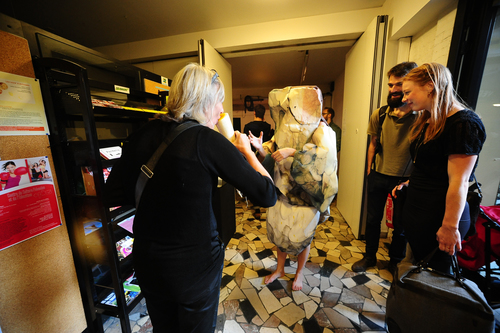The exhibition project Middle Gate II – The Story of Dymphna is a collaboration between M HKA (Museum of Contemporary Art Antwerp) and the cultural centre de Werft in Geel. Middle Gate II is the follow up to the exhibition Middle Gate, curated by Jan Hoet in Geel in 2013. The exhibition concept is closely tied to the legend of the holy Dymphna, saint of the possessed, the mentally ill and patroness against epilepsy and insanity. The legend of Dymphna shares a strong connection to the identity of Geel, "the charitable city".
Michèle Matyn
Dropstein character, 2013
The cluster of works titled Dropstein (derived from the German: Tropfsteinhöhle) developed out of a journey to the stairs of the Bronze Age city of Mycenae in Greece. It comprises a series of photos and a performance, based on stalactite forms inside caves. The work symbolises the idea that you become what you experience, like the way stalactites gradually grow through the flow of mineral deposits in water that build on top of the old ones. The stalactite images resemble stairs and passageways leading into the depths of caves. They were subsequently used in the Dropstein performance, for which the images were turned into a costume.
“Matyn processes the knowledge and experience she gains, during her travels for example, into what she calls a second skin, a costumed character. She collects stories, anecdotes, found imagery, elements of nature, … all of this feeds her and allows her to come closer to het surroundings. The characters that emerge from this process perform actions that reflect an experience of her travels or, they restage rituals and ancient customs that transport us to an enchanted world in which boundaries between humans and animals, between nature and culture were not drawn sharply. One of these characters is ‘Dropstein’, a stalactite that takes the form of what he has experienced, modeled after a stalactite cave that shapes and takes it form over time. These characters form, in her own words, a kind of portal, a passageway that leads us beyond the usual black and white way of thinking into a world that is not dominated by a soulless material and rational approach.” - Maaike Lauwaert, 2014





